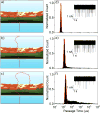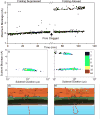DNA Translocations through Nanopores under Nanoscale Preconfinement
- PMID: 29087723
- PMCID: PMC5814347
- DOI: 10.1021/acs.nanolett.7b03987
DNA Translocations through Nanopores under Nanoscale Preconfinement
Abstract
To reduce unwanted variation in the passage speed of DNA through solid-state nanopores, we demonstrate nanoscale preconfinement of translocating molecules using an ultrathin nanoporous silicon nitride membrane separated from a single sensing nanopore by a nanoscale cavity. We present comprehensive experimental and simulation results demonstrating that the presence of an integrated nanofilter within nanoscale distances of the sensing pore eliminates the dependence of molecular passage time distributions on pore size, revealing a global minimum in the coefficient of variation of the passage time. These results provide experimental verification that the inter- and intramolecular passage time variation depends on the conformational entropy of each molecule prior to translocation. Furthermore, we show that the observed consistently narrower passage time distributions enables a more reliable DNA length separation independent of pore size and stability. We also demonstrate that the composite nanofilter/nanopore devices can be configured to suppress the frequency of folded translocations, ensuring single-file passage of captured DNA molecules. By greatly increasing the rate at which usable data can be collected, these unique attributes will offer significant practical advantages to many solid-state nanopore-based sensing schemes, including sequencing, genomic mapping, and barcoded target detection.
Keywords: DNA; Nanopore; entropy; nanoconfinement; nanofabrication; nanotechnology.
Conflict of interest statement
JLM declares a competing financial interest as a co-founder and equity holder of SiMPore Inc., a commercial manufacturer of NPN and silicon-based membrane materials. VTC and KB declare a competing financial interest in the form of a patent on the nanofiltered nanopore device. All other authors declare no competing financial interest.
Figures






References
Publication types
MeSH terms
Substances
Grants and funding
LinkOut - more resources
Full Text Sources
Other Literature Sources

